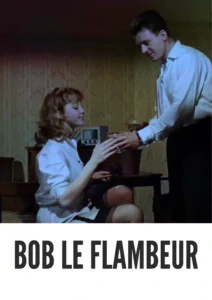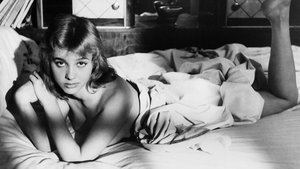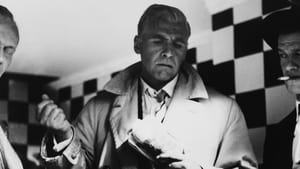Contact: [email protected]
Video Sources 0 Views
- Watch trailer
- Bob le Flambeur


Synopsis
Table of Contents
ToggleBob le Flambeur 1956: A Colorful Review of a Classic French Noir

Introduction
Bob le Flambeur 1956, a cornerstone of French cinema, emerges anew in its early colored version, adding a vibrant layer to its already captivating narrative. In this article, we delve into the impact of colorization on the viewing experience of Bob le Flambeur 1956, exploring its significance in the realm of film history.
Check The Full Colorized Movies List
Check Our Colorized Movies Trailer Channel
Understanding Bob le Flambeur 1956: Director, Cast, and Genre
Directed by the visionary Jean-Pierre Melville, Bob le Flambeur 1956 showcases the epitome of French noir cinema. With the charismatic Roger Duchesne in the titular role and a stellar supporting cast, including Isabelle Corey and Daniel Cauchy, the film captures the essence of the genre with unparalleled finesse.
Jean-Pierre Melville, known for his mastery of the noir genre, brings his signature style to Bob le Flambeur 1956. With its atmospheric cinematography, moody lighting, and jazz-infused soundtrack, the film immerses viewers in the gritty underworld of 1950s Paris. Roger Duchesne delivers a standout performance as Bob, the suave yet troubled protagonist whose gambling addiction leads him down a dangerous path. Isabelle Corey shines as Anne, the enigmatic femme fatale who captures Bob’s heart, while Daniel Cauchy adds depth to the ensemble cast with his portrayal of the loyal but conflicted Paolo.
Exploring the World of Bob le Flambeur 1956: Plot and Characters
Set against the backdrop of 1950s Paris, Bob le Flambeur 1956 follows the enigmatic Bob as he plans one final heist, hoping to secure his financial future. As the intricate plot unfolds, viewers are drawn into a world of deception, betrayal, and moral ambiguity, with each character contributing to the film’s rich tapestry.
Bob, a former gambler turned nightclub owner, finds himself drawn back into the world of high-stakes gambling when a lucrative opportunity presents itself. With the help of his loyal friends and a young protege, Bob devises a daring plan to rob a casino, unaware that his actions will set off a chain of events that will forever alter the course of his life.
As Bob navigates the dangerous underworld of Paris, he finds himself torn between loyalty to his friends and the allure of easy money. Along the way, he encounters a cast of colorful characters, including the seductive Anne and the ruthless gangster Marc, each with their own motives and agendas. As tensions rise and loyalties are tested, Bob must confront his own demons and make a fateful decision that will determine his fate.
The Art of Film Colorization
Colorization breathes new life into Bob le Flambeur 1956, enhancing its visual allure while preserving its vintage charm. Through the meticulous application of color, each frame is imbued with a sense of vibrancy and depth, elevating the viewing experience to new heights.
The decision to colorize Bob le Flambeur 1956 was met with both anticipation and skepticism from fans and critics alike. While some purists may argue that the film should be preserved in its original black and white format, others see colorization as a means of making classic films more accessible to modern audiences. In the case of Bob le Flambeur 1956, colorization serves to enhance the film’s visual impact, bringing the streets of Paris to life with vibrant hues and tones.
Early Colored Films: A Brief History
The evolution of early colored techniques in cinema paved the way for a new era of visual storytelling. From hand-tinted frames to innovative colorization processes, filmmakers continually pushed the boundaries of creativity, leaving an indelible mark on the medium.
In the early days of cinema, black and white films were the norm, with filmmakers using lighting, shadow, and composition to create mood and atmosphere. However, as technology advanced, filmmakers began experimenting with color, leading to the emergence of early colored techniques such as hand-painting and tinting.
One of the earliest examples of colorization in cinema is Georges Méliès’ A Trip to the Moon (1902), which featured hand-painted frames to create vivid, otherworldly imagery. Over time, colorization techniques became more sophisticated, with the introduction of processes such as Technicolor and Eastmancolor revolutionizing the way films were made and viewed.
Bob le Flambeur 1956 and Its Early Colored Version
The decision to release Bob le Flambeur 1956 in a colorized format reflects a commitment to preserving its legacy for future generations. While some may debate the merits of colorization, there is no denying its ability to breathe new life into classic films, revitalizing them for contemporary audiences.
For many viewers, the early colored version of Bob le Flambeur 1956 offers a fresh perspective on a beloved classic. By adding color to the film’s atmospheric visuals, colorization enhances its aesthetic appeal, drawing viewers deeper into the world of 1950s Paris. From the neon-lit streets to the smoky gambling dens, the colors serve to accentuate the film’s noir aesthetic, adding depth and dimension to each scene.
The Debate Over Film Colorization
The controversy surrounding film colorization underscores the complex relationship between art and technology. While purists may argue for the preservation of films in their original state, others see colorization as a means of making old classics more accessible to modern audiences.
One of the main arguments against colorization is that it alters the director’s original vision and compromises the integrity of the film. Critics argue that colorization can detract from the intended mood and atmosphere of a film, turning a noir masterpiece into a garish spectacle.
However, proponents of colorization argue that it breathes new life into old classics, making them more appealing to contemporary audiences. By adding color to black and white films, colorization can enhance the visual impact of a film, drawing viewers deeper into the story and characters.
Examining Bob le Flambeur 1956 as an Early Colored Film
Colorization enhances the visual appeal of Bob le Flambeur 1956, complementing its stylish cinematography and evocative mise-en-scène. From the smoky Parisian streets to the dimly lit gambling dens, the colors serve to underscore the film’s noir aesthetic, adding depth and dimension to each scene.
The use of color also adds an extra layer of symbolism to the film, with certain colors carrying thematic significance. For example, the use of red may symbolize danger or passion, while blue may evoke feelings of melancholy or isolation. By manipulating color in this way, filmmakers can enhance the emotional impact of a scene and convey deeper meaning to the audience.
Influence and Legacy: Bob le Flambeur 1956’s Impact on Cinema
Bob le Flambeur 1956’s enduring legacy is a testament to its timeless appeal and cultural significance. Its influence can be seen in the works of countless filmmakers, both in France and abroad, who have drawn inspiration from its innovative storytelling and iconic imagery.
One of the most notable examples of Bob le Flambeur 1956’s influence is its impact on the heist genre, with films such as Ocean’s Eleven (2001) and The Italian Job (2003) paying homage to its stylish direction and intricate plot twists. Additionally, the film’s exploration of moral ambiguity and existential themes has resonated with audiences across generations, cementing its status as a classic of French cinema.
Director’s Cinematic Legacy: Beyond Bob le Flambeur 1956
Jean-Pierre Melville’s contributions to cinema extend far beyond Bob le Flambeur 1956, with a body of work that continues to resonate with audiences worldwide. His unique vision and distinct aesthetic have left an indelible mark on the art of filmmaking, influencing generations of filmmakers to come.
Melville, often hailed as the godfather of French noir cinema, is known for his minimalist style, meticulous attention to detail, and exploration of existential themes. From Le Samouraï (1967) to Le Cercle Rouge (1970), his films have captivated audiences with their moody atmosphere, complex characters, and gripping narratives.
Themes Explored in Bob le Flambeur 1956
At its core, Bob le Flambeur 1956 explores themes of fate, redemption, and the allure of the criminal underworld. Through its morally ambiguous characters and intricate plot twists, the film offers a compelling commentary on the human condition and the choices we make in pursuit of our desires.
Bob, the film’s protagonist, grapples with his own sense of morality as he navigates the dangerous world of gambling and crime. His journey is one of self-discovery and redemption, as he confronts his own demons and ultimately comes to terms with the consequences of his actions.
Reception and Controversy Surrounding Bob le Flambeur 1956
Upon its release, Bob le Flambeur 1956 garnered critical acclaim for its stylish direction, atmospheric cinematography, and memorable performances. While some may debate the merits of colorization, there is no denying the film’s impact on audiences and its enduring place in cinematic history.
Critics praised the film’s evocative visuals, moody atmosphere, and nuanced portrayal of its characters. Roger Duchesne’s performance as Bob was particularly lauded, with critics hailing him as a charismatic and enigmatic leading man.
Where to Watch Bob le Flambeur 1956 Online
For those eager to experience the timeless charm of Bob le Flambeur 1956, the film is available for streaming on various platforms, ensuring that its legacy will continue to captivate audiences for years to come.
FAQs About Bob le Flambeur 1956
Frequently Asked Questions (FAQs) about Bob le Flambeur 1956 provide valuable insights into various aspects of the film, from its production history to its cultural impact:
1. What is the plot of Bob le Flambeur 1956?
Bob le Flambeur 1956 follows the story of an aging gambler named Bob who plans one final heist in an attempt to secure his financial future. As the intricate plot unfolds, Bob finds himself drawn into a web of deception and betrayal, leading to a dramatic climax that will leave viewers on the edge of their seats.
2. Who are the main actors in Bob le Flambeur 1956?
The main actors in Bob le Flambeur 1956 include Roger Duchesne as Bob, Isabelle Corey as Anne, and Daniel Cauchy as Paolo. Together, they deliver captivating performances that bring the film’s characters to life and elevate the viewing experience to new heights.
3. What is the significance of colorization in Bob le Flambeur 1956?
Colorization adds a new layer of visual richness to Bob le Flambeur 1956, enhancing its aesthetic appeal while preserving its vintage charm. By infusing each frame with vibrant hues and tones, colorization breathes new life into the classic film, revitalizing it for contemporary audiences.
4. How does Bob le Flambeur 1956 compare to other films of its genre?
Bob le Flambeur 1956 stands out among other films of its genre due to its stylish direction, atmospheric cinematography, and memorable performances. Director Jean-Pierre Melville’s innovative storytelling and iconic imagery have cemented the film’s status as a classic of French noir cinema, inspiring countless filmmakers and audiences alike.
5. Where can I watch Bob le Flambeur 1956 online?
Bob le Flambeur 1956 is available for streaming on various platforms, allowing audiences to experience the timeless charm of this classic French noir from the comfort of their own homes. Whether viewed in its original black and white format or the vibrant hues of colorization, Bob le Flambeur 1956 promises an unforgettable cinematic journey.
Conclusion
In conclusion, Bob le Flambeur 1956 remains a timeless classic that continues to captivate audiences with its stylish direction, atmospheric cinematography, and memorable performances. Whether viewed in its original black and white format or the early colored version, the film offers a compelling exploration of fate, redemption, and the allure of the criminal underworld. As we reflect on its enduring legacy and cultural significance, we are reminded of the power of cinema to entertain, inspire, and provoke thought, making Bob le Flambeur 1956 a true masterpiece of French noir cinema.












